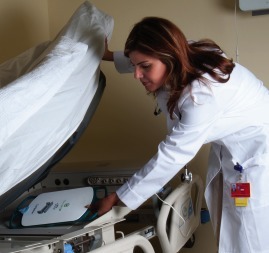New Hampshire hospital implements EarlySense continuous patient monitoring sensors
by
John R. Fischer, Senior Reporter | July 03, 2017

The time it takes for a nurse to respond to an inpatient’s needs can vary between different hospitals. In some facilities, assistance typically arrives in as few as three minutes, while others take more than five.
But patients at St. Joseph Hospital could receive help in as little as two, now that is has become the first hospital in New Hampshire to utilize EarlySense’s contact-free continuous patient monitoring solution system in its medical surgical unit.
“When we first put our system in, you could see a response time, depending on the environment, four minutes, maybe five minutes to an alert,” said Tim O’Malley, the president of EarlySense. “After we implement the system, that response time, many times, is well under two minutes. And many times, it’s under one minute.”
The system consists of sensors which are placed underneath the mattresses of patients, tracking their respiratory and heart rates as well as their movements when awake and asleep. Following any changes in these conditions, such as a drop in breathing, an alert is issued to hospital staff via their pagers, allowing them to respond quickly to those in need.
A sensor can compile more than 20,000 data points on a patient’s condition in four hours, far surpassing the number of vital signs that a nurse or doctor can check over that same length of time. Staff members may also only be able to accommodate patients every three or four hours on rounds whereas a sensor acts as a continuous monitor.
The device’s main focus is on respiratory and heart rates with the thousands of data points it collects providing medical staff with a more thorough understanding of when, specifically, a change or pattern of changes took place in a person’s body, and what the cause may be.
“Heart rate and especially respiratory rate are the earliest indicators of physiological change with a person,” said O’Malley. “And so having that monitored so frequently and on a continuous basis gives a lot of insight into what could potentially happen in a patient that would be considered an adverse event.”
The system also analyzes movement, alerting staff to patients who need assistance getting up and walking around or who require shifting in bed, thereby reducing the possibility of ulcers developing and lowering the number of preventable falls.
A January 2016 press release found that the system prevented 483 falls and 2,073 ulcers among 84,000 patients worldwide in 2015. In addition, it helped save 332 lives, reduced days spent in the hospital among all patients together by 27,594 and saved health care facilities across the globe an estimated $18 million.
St. Joseph Hospital first implemented the system on one floor in the fall of 2016, according to O’Malley and has since installed it on a second floor. The floors are two of more than 120 in hospitals and care facilities across the U.S. that rely on EarlySense.
|
|
|
You Must Be Logged In To Post A Comment
|
